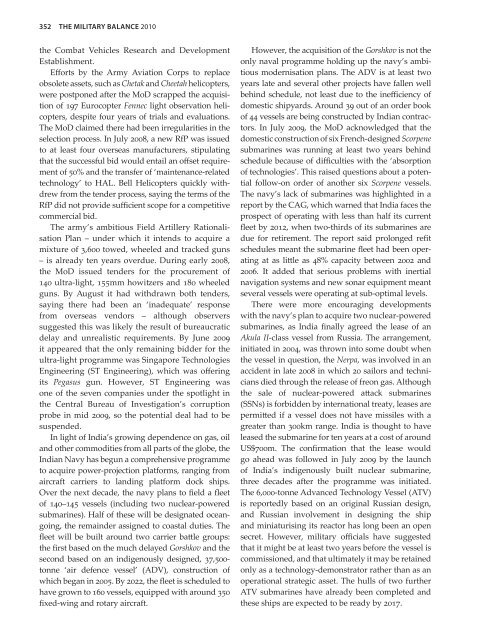You also want an ePaper? Increase the reach of your titles
YUMPU automatically turns print PDFs into web optimized ePapers that Google loves.
352 The MiliTAry BAlAnCe 2010<br />
the Combat Vehicles Research and Development<br />
Establishment.<br />
Efforts by the Army Aviation Corps to replace<br />
obsolete assets, such as Chetak and Cheetah helicopters,<br />
were postponed after the MoD scrapped the acquisition<br />
of 197 Eurocopter Fennec light observation helicopters,<br />
despite four years of trials and evaluations.<br />
The MoD claimed there had been irregularities in the<br />
selection process. In July 2008, a new RfP was issued<br />
to at least four overseas manufacturers, stipulating<br />
that the successful bid would entail an offset requirement<br />
of 50% and the transfer of ‘maintenance-related<br />
technology’ to HAL. Bell Helicopters quickly withdrew<br />
from the tender process, saying the terms of the<br />
RfP did not provide sufficient scope for a competitive<br />
commercial bid.<br />
The army’s ambitious Field Artillery Rationalisation<br />
Plan – under which it intends to acquire a<br />
mixture of 3,600 towed, wheeled and tracked guns<br />
– is already ten years overdue. During early 2008,<br />
the MoD issued tenders for the procurement of<br />
140 ultra-light, 155mm howitzers and 180 wheeled<br />
guns. By August it had withdrawn both tenders,<br />
saying there had been an ‘inadequate’ response<br />
from overseas vendors – although observers<br />
suggested this was likely the result of bureaucratic<br />
delay and unrealistic requirements. By June 2009<br />
it appeared that the only remaining bidder for the<br />
ultra-light programme was Singapore Technologies<br />
Engineering (ST Engineering), which was offering<br />
its Pegasus gun. However, ST Engineering was<br />
one of the seven companies under the spotlight in<br />
the Central Bureau of Investigation’s corruption<br />
probe in mid 2009, so the potential deal had to be<br />
suspended.<br />
In light of India’s growing dependence on gas, oil<br />
and other commodities from all parts of the globe, the<br />
Indian Navy has begun a comprehensive programme<br />
to acquire power-projection platforms, ranging from<br />
aircraft carriers to landing platform dock ships.<br />
Over the next decade, the navy plans to field a fleet<br />
of 140–145 vessels (including two nuclear-powered<br />
submarines). Half of these will be designated oceangoing,<br />
the remainder assigned to coastal duties. The<br />
fleet will be built around two carrier battle groups:<br />
the first based on the much delayed Gorshkov and the<br />
second based on an indigenously designed, 37,500tonne<br />
‘air defence vessel’ (ADV), construction of<br />
which began in 2005. By 2022, the fleet is scheduled to<br />
have grown to 160 vessels, equipped with around 350<br />
fixed-wing and rotary aircraft.<br />
However, the acquisition of the Gorshkov is not the<br />
only naval programme holding up the navy’s ambitious<br />
modernisation plans. The ADV is at least two<br />
years late and several other projects have fallen well<br />
behind schedule, not least due to the inefficiency of<br />
domestic shipyards. Around 39 out of an order book<br />
of 44 vessels are being constructed by Indian contractors.<br />
In July 2009, the MoD acknowledged that the<br />
domestic construction of six French-designed Scorpene<br />
submarines was running at least two years behind<br />
schedule because of difficulties with the ‘absorption<br />
of technologies’. This raised questions about a potential<br />
follow-on order of another six Scorpene vessels.<br />
The navy’s lack of submarines was highlighted in a<br />
report by the CAG, which warned that India faces the<br />
prospect of operating with less than half its current<br />
fleet by 2012, when two-thirds of its submarines are<br />
due for retirement. The report said prolonged refit<br />
schedules meant the submarine fleet had been operating<br />
at as little as 48% capacity between 2002 and<br />
2006. It added that serious problems with inertial<br />
navigation systems and new sonar equipment meant<br />
several vessels were operating at sub-optimal levels.<br />
There were more encouraging developments<br />
with the navy’s plan to acquire two nuclear-powered<br />
submarines, as India finally agreed the lease of an<br />
Akula II-class vessel from Russia. The arrangement,<br />
initiated in 2004, was thrown into some doubt when<br />
the vessel in question, the Nerpa, was involved in an<br />
accident in late 2008 in which 20 sailors and technicians<br />
died through the release of freon gas. Although<br />
the sale of nuclear-powered attack submarines<br />
(SSNs) is forbidden by international treaty, leases are<br />
permitted if a vessel does not have missiles with a<br />
greater than 300km range. India is thought to have<br />
leased the submarine for ten years at a cost of around<br />
US$700m. The confirmation that the lease would<br />
go ahead was followed in July 2009 by the launch<br />
of India’s indigenously built nuclear submarine,<br />
three decades after the programme was initiated.<br />
The 6,000-tonne Advanced Technology Vessel (ATV)<br />
is reportedly based on an original Russian design,<br />
and Russian involvement in designing the ship<br />
and miniaturising its reactor has long been an open<br />
secret. However, military officials have suggested<br />
that it might be at least two years before the vessel is<br />
commissioned, and that ultimately it may be retained<br />
only as a technology-demonstrator rather than as an<br />
operational strategic asset. The hulls of two further<br />
ATV submarines have already been completed and<br />
these ships are expected to be ready by 2017.


